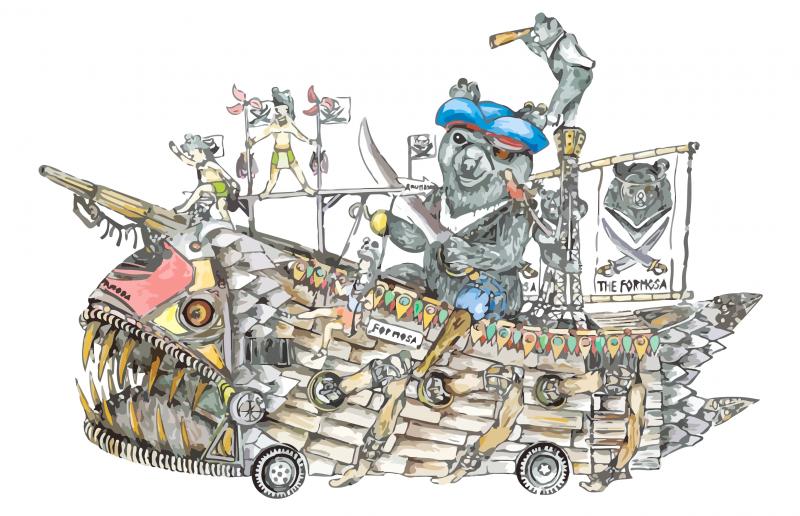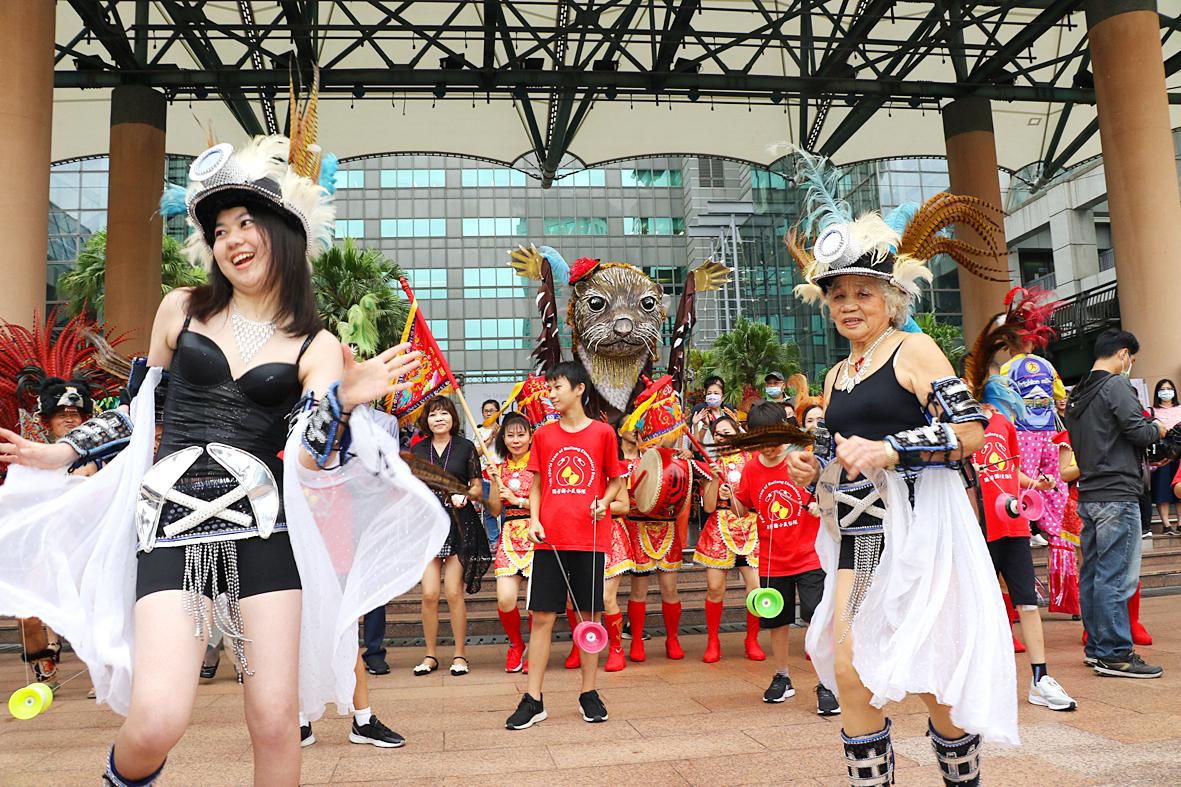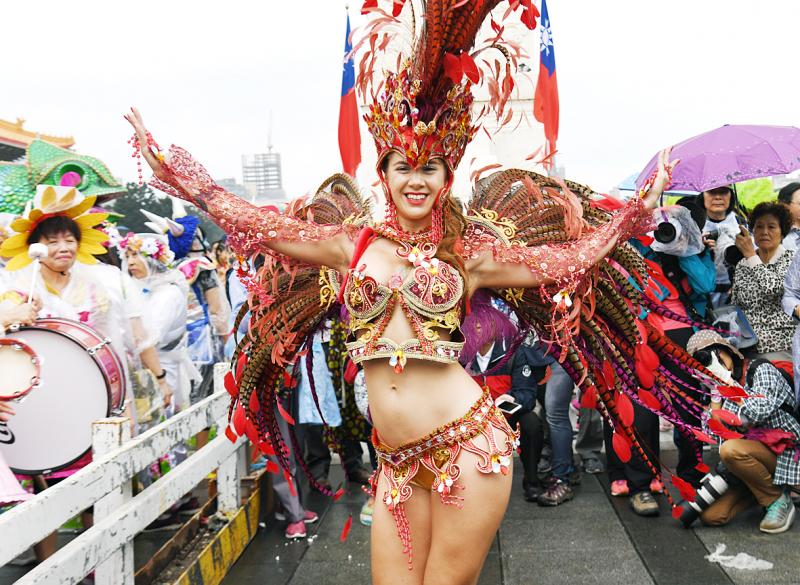Just over two decades ago, Gordon Tsai (蔡聰明) founded the Dream Community (夢想社區文教發展基金) on rezoned farmland owned by his family in what was then Taipei County’s Sijhih District (汐止), aiming to create a place where art and creativity would be part of residents’ daily lives.
One of the rules for people who bought apartments in the community was that they had to take part in a certain number of art events every year.
To help residents reach that goal, Tsai dreamed of sponsoring an annual parade that would combine elements of Mardi Gras in New Orleans, Brazilian carnival and the annual Burning Man festival in Nevada — costumes, samba dancers and drummers and community-built floats — as a way of fostering a sense of community not just for his neighborhood, but throughout the nation.

Illustration courtesy of the Dream Community
The Dream Community held its first Dream Parade in 2002, a small affair on nearby streets.
Over the years the parade has grown in size and scope, as the community hosted foreign and Taiwanese artists to live with them in Sijhih for months at a time, creating costumes and floats from recycled materials or teaching samba drumming or other skills.
Tsai’s Dream Community Cultural and Educational Development Foundation (夢想社區文教發展基金會) also created an outreach program that sent Brazilian drummers and others to teach samba drumming to elementary and junior-high schools in Aboriginal communities around the nation, helping them create drumming teams that would then compete to take part in the annual parades.

Photo: Lai Hsiao-tung, Taipei Times
While the Dream Community now likes to say it hosts the “largest Chinese carnival parade in the world,” the Dream Parade is basically a one-of-a-kind, only in Taiwan kind of event, with the body-painted, loin-cloth-clad, feathered headdress wearing Tsai acting as perennial cheerleader from atop a float or performing fire-breathing tricks up and down the parade route.
It draws hundreds of participants from families, schools and community groups, ranging in age from toddlers in strollers to the now-famous “samba grannies,” whose photographs make it into media around the world.
For the past few years, the Taipei City Government was a cosponsor and the parade became a mark-it-on-your-calendar feature for a mid-October Saturday, staged between Liberty Square and Ketagalan Boulevard, with themes that varied from environmental protection to Hakka culture to Taiwan storytelling.

Photo: CNA
Last year, the foundation partnered with the Taiwan Black Bear Conservation Association (台灣黑熊保育協會) to promote animal conservation as well as environmental protection.
The association is back as a co-organizer this year, but the New Taipei City Government invited Tsai and the foundation to move the parade to the Xinban Special District in Banciao District (板橋) — and asked it to shift from a Saturday date to tomorrow to take advantage of the Double Ten National Day long weekend.
The Taiwan Association of Traditional Chinese Veterinary Medicine (臺灣中獸醫藥學會) has also joined up, as the foundation decided that in this COVID-19 stricken year the theme of the parade should include “health and happiness” as well as animal protection and environmental protection.
Forty teams will be marching/performing in the parade, which is scheduled to start at 3pm from Chongqing Road — near Fuzhong MRT Station Exit 2 — before heading down Zhongshan Road to Xinfu Road to Xianmin Boulevard and the New Taipei City Plaza, near Banciao Station.
There will be three large floats, favorites from previous parades: a giant hand woven from bamboo originally designed for a Burning Man event; the monster-fish float that was refashioned last year to include a Formosan Black Bear as captain; and ROBOGAN, made from scrap metal parts.
The Taiwan Chinese Veterinary Medicine Association has organized a LOHAS Market with booths and activities provided by Chinese medicine and pet food suppliers, veterinarians and Chinese medicine doctors and non-governmental organizations, including bone-density tests for the elderly and free health exams for senior pets.
The market will be held at New Taipei City Plaza from 11am to 9pm, and the plaza will also be the site of the post-parade celebration party from 6pm to 9pm.
More information on the parade route is available online: www.art-dreams.com/dream-parade.html.

June 2 to June 8 Taiwan’s woodcutters believe that if they see even one speck of red in their cooked rice, no matter how small, an accident is going to happen. Peng Chin-tian (彭錦田) swears that this has proven to be true at every stop during his decades-long career in the logging industry. Along with mining, timber harvesting was once considered the most dangerous profession in Taiwan. Not only were mishaps common during all stages of processing, it was difficult to transport the injured to get medical treatment. Many died during the arduous journey. Peng recounts some of his accidents in

“Why does Taiwan identity decline?”a group of researchers lead by University of Nevada political scientist Austin Wang (王宏恩) asked in a recent paper. After all, it is not difficult to explain the rise in Taiwanese identity after the early 1990s. But no model predicted its decline during the 2016-2018 period, they say. After testing various alternative explanations, Wang et al argue that the fall-off in Taiwanese identity during that period is related to voter hedging based on the performance of the Democratic Progressive Party (DPP). Since the DPP is perceived as the guardian of Taiwan identity, when it performs well,

A short walk beneath the dense Amazon canopy, the forest abruptly opens up. Fallen logs are rotting, the trees grow sparser and the temperature rises in places sunlight hits the ground. This is what 24 years of severe drought looks like in the world’s largest rainforest. But this patch of degraded forest, about the size of a soccer field, is a scientific experiment. Launched in 2000 by Brazilian and British scientists, Esecaflor — short for “Forest Drought Study Project” in Portuguese — set out to simulate a future in which the changing climate could deplete the Amazon of rainfall. It is

The Taiwan People’s Party (TPP) on May 18 held a rally in Taichung to mark the anniversary of President William Lai’s (賴清德) inauguration on May 20. The title of the rally could be loosely translated to “May 18 recall fraudulent goods” (518退貨ㄌㄨㄚˋ!). Unlike in English, where the terms are the same, “recall” (退貨) in this context refers to product recalls due to damaged, defective or fraudulent merchandise, not the political recalls (罷免) currently dominating the headlines. I attended the rally to determine if the impression was correct that the TPP under party Chairman Huang Kuo-Chang (黃國昌) had little of a